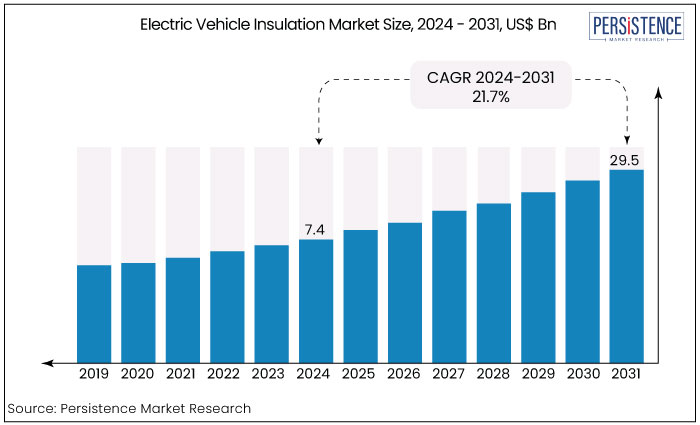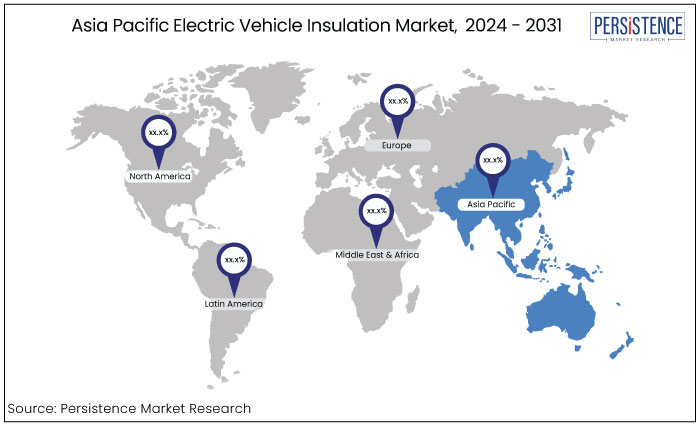Industry: Automotive & Transportation
Published Date: October-2024
Format: PPT*, PDF, EXCEL
Delivery Timelines: Contact Sales
Number of Pages: 179
Report ID: PMRREP34865
The electric vehicle insulation market is estimated to increase from US$7.4 Bn in 2024 to US$29.5 Bn by 2031. The market is projected to record a healthy CAGR of 21.7% during the forecast period from 2024 to 2031. Growing demand for electric vehicles, and environmental concerns are fueling the market for electric vehicle insulation.

Key Highlights of the Market
|
Market Attributes |
Key Insights |
|
Market Size (2024E) |
US$7.4 Bn |
|
Projected Market Value (2031F) |
US$29.5 Bn |
|
Global Market Growth Rate (CAGR 2024 to 2031) |
21.7% |
|
Historical Market Growth Rate (CAGR 2019 to 2023) |
15.6% |
Asia Pacific is projected to command the notable market share of the electric vehicle insulation market throughout the forecast period. Key factors driving revenue growth in this area include increasing initiatives to promote renewable energy usage, a surge in electric vehicle (EV) adoption, and a heightened focus on enhancing vehicle safety by mitigating risks associated with electrical failures and fires.
Manufacturers are integrating advanced cooling systems that monitor and regulate battery temperatures thereby minimizing fire hazards to address the potential for thermal runaway due to battery malfunctions,
Insulating materials like ceramic coatings and fire-resistant barriers are being employed to protect battery packs from external heat sources. China's substantial investments in renewable energy and new regulations such as the "14th Five Year Plan for a Modern Energy System," further bolster market expansion.

Under the bonnet and battery pack application segment is expected to dominate the electric vehicle insulation market during the forecast period. This trend is driven by the necessity to insulate crucial components such as batteries and electric motors in battery electric vehicles (BEVs).
In Plug-in Hybrid Electric Vehicles (PHEVs) insulation is required not only for the battery and electric motor but also for the internal combustion engine (ICE) and various other components. Effective insulation is essential for managing thermal performance, enhancing energy efficiency, and ensuring the safety and longevity of these systems. As the demand for electric vehicles grows, the significance of insulation in these applications will continue to expand marking a key area for market development.
The battery electric vehicle (BEV) segment is anticipated to emerge as the leading propulsion type for electric vehicle insulation throughout the forecast period. This growth is primarily attributed to the increasing production of BEVs, which are recognized for their emission-free technology, aligning with global sustainability goals.
BEVs typically feature larger battery packs compared to Plug-in Hybrid Electric Vehicles (PHEVs), which significantly heightens the demand for effective insulation solutions. The need for efficient thermal management and enhanced safety in these larger battery systems will further propel the adoption of advanced insulation materials.
As manufacturers focus on optimizing performance and energy efficiency, the BEV segment is poised for substantial growth in the electric vehicle insulation market.
The electric vehicle insulation market encompasses detailed information about materials and technologies designed to enhance the thermal and electrical performance of electric vehicles (EVs). This insulation is crucial for ensuring safety, efficiency, and longevity of EV components particularly the battery and electric motor systems.
Insulation materials work by preventing heat transfer, minimizing energy loss, and protecting sensitive electrical components from environmental factors. Common uses include thermal insulation for batteries to maintain optimum operating temperatures and electrical insulation to prevent short circuits.
As the demand for EVs grows so does the need for innovative insulation solutions that meet stringent safety standards and improve overall vehicle performance. The industry is witnessing significant growth driven by advancements in technology and increasing environmental awareness.
A notable trend is a shift toward lightweight and high-performance insulation materials. Additionally, the integration of smart insulation systems provides valuable data for vehicle management.
Regulatory pressures for improved safety and emissions standards further propel innovation in insulation technologies. Furthermore, the rising adoption of electric vehicles globally is expected to sustain robust growth in this market as manufacturers seek to optimize designs and enhance the overall driving experience.
The electric vehicle insulation market has shown remarkable growth during the period from 2019 to 2023, with a CAGR of 15.7%. This surge can be attributed to the increasing demand for electric vehicles driven by environmental concerns, government incentives, and the advancement of battery technologies.
As manufacturers strive to enhance vehicle efficiency and safety, the need for effective insulation solutions has become paramount. The market is estimated to accelerate further with an impressive 21.7% CAGR during the forecast period from 2024 to 2031. This anticipated growth is fueled by ongoing innovations in insulation materials such as lightweight composites and advanced thermal management systems.
The expansion of charging infrastructure and rising consumer acceptance of electric vehicles will contribute to creating several electric vehicle insulation market opportunities. As automakers focus on developing efficient and sustainable vehicles, the sector is poised to play a critical role in shaping the future of transportation.
Rising Demand for Electric Vehicles
The growing demand for electric vehicles (EVs) is a primary growth driver for electric vehicle insulation market.
As governments globally implement stringent emissions regulations and offer incentives for EV adoption, consumer interest in sustainable transportation solutions is surging. This trend is bolstered by advancements in battery technology, which enhance the range and performance of EVs, making them more appealing to buyers. Consequently, automakers are increasingly investing in innovative insulation materials to ensure optimal thermal management and electrical safety in their vehicles.
The growing emphasis on reducing energy loss and enhancing vehicle efficiency further propels the need for high-quality insulation solutions positioning the electric vehicle insulation market for sustained growth in the coming years.
Advancements in Insulation Technologies
Technological advancements in insulation materials are significantly driving the electric vehicle insulation market growth. Innovations such as lightweight composites, aerogels, and nanomaterials are being developed to meet the unique demands of electric vehicles. These advanced materials provide superior thermal and electrical insulation properties while minimizing weight, which is crucial for enhancing EV performance and efficiency.
The integration of smart insulations systems that can monitor temperature fluctuations and performance metrics is gaining traction. Such innovations improve the safety and reliability of electric vehicles and contribute to better energy management thereby increasing the overall appeal of EVs. As these technologies continue to evolve, they will play a pivotal role in shaping the future of the insulation market.
Regulatory Pressures and Environmental Concerns
Increasing regulatory pressures and growing environmental concerns are key drivers for the electric vehicle insulation market expansion. Governments globally are implementing stringent regulations to reduce carbon emissions and promote sustainable practices within the automotive industry. These regulations encourage automakers to prioritize energy efficiency and safety in their vehicle designs leading to a heightened focus on insulation solutions.
Consumers are becoming environmentally conscious seeking products that align with their values of sustainability. This shift in consumer behavior compels manufacturers to adopt advanced insulation technologies that enhance vehicle performance and reduce environmental impact. As the push for green transportation intensifies, demand for effective insulation solutions in electric vehicles is expected to rise significantly.
High Production Costs
One significant factor impeding electric vehicle insulation market is the high production costs associated with advanced insulation materials. The development and manufacturing of innovative insulation solutions such as lightweight composites and nanomaterials often require substantial investment in research and development.
High costs can be a barrier for manufacturers particularly small companies limiting their ability to compete in the market. Additionally, the high costs can be passed on to consumers, potentially deterring them from purchasing electric vehicles, thereby slowing market growth.
Limited Awareness and Adoption
Another factor hindering the electric vehicle insulation market is consumers' limited awareness and adoption of electric vehicles. Despite the growing interest in sustainable transportation, many potential buyers remain unaware of the benefits of EVs, including the role of insulation in enhancing performance and safety.
Lack of understanding can lead to hesitancy in adopting electric vehicles, which in turn affects the demand for insulation solutions. Furthermore, perceiving electric vehicles as less reliable or more expensive than traditional vehicles can further impede market growth.
Integration of Smart Insulation Technologies
One promising future opportunity for the electric vehicle insulation market lies in the integration of smart insulation technologies. As the automotive industry increasingly embraces connected and autonomous vehicle technologies, there is a growing demand for insulation solutions that can monitor and adapt to varying conditions.
Smart insulation systems equipped with sensors can track temperature fluctuations, battery performance, and overall vehicle health providing real-time data to optimize energy efficiency and safety. This advancement not only enhances the performance of electric vehicles but also allows manufacturers to create more intelligent and responsive designs.
By investing in the development of these innovative insulation solutions, companies can position themselves at the forefront of the market and meet the evolving needs of consumers and regulatory standards.
Supportive Government Regulations
Heat management can impact the overall performance of electric vehicles, making battery safety increasingly important. In response, government agencies are implementing stringent regulations aimed at enhancing the security of battery packs. For instance,
Under these new regulations, manufacturers must demonstrate that the batteries in their electric vehicles retain over 80% of their original capacity after five years or 100,000 kilometers. These regulations established as a UN Global Technical Regulation (UNGTR) will compel EV manufacturers to integrate heat management systems for batteries consequently driving electric vehicle insulation market growth.
The market is characterized by intense competition among key players focused on innovation and performance enhancements. Companies like BASF have launched advanced thermal management materials such as their Elastoflex® series, which improve energy efficiency and safety in EV batteries since 2022.
3M introduced its Thermal Insulation Solutions, designed for high-temperature applications, ensuring optimal performance in electric vehicles. Another notable player, Honeywell, has developed Aerospace-grade insulation materials that are lightweight and effective, catering to the growing demand for enhanced vehicle efficiency. These innovations reflect the industry's commitment to advancing insulation technologies to meet the evolving needs of electric vehicle manufacturers.
Recent Developments in the Electric Vehicle Insulation Market
|
Attributes |
Details |
|
Forecast Period |
2024 to 2031 |
|
Historical Data Available for |
2019 to 2023 |
|
Market Analysis |
US$ Million for Value |
|
Key Regions Covered |
|
|
Key Market Segments Covered |
|
|
Key Companies Profiled |
|
|
Report Coverage |
|
|
Customization & Pricing |
Available upon request |
By Product Type
By Propulsion Type
By Application
By Region
To know more about delivery timeline for this report Contact Sales

The market is predicted to rise from US$7.4 Bn in 2024 to US$29.5 Bn by 2031.
Some of the leading industry players in the market are 3M, CYG TEFA Co. Ltd., Armacell International S.A., Sika Automotive AG, and ADDEV.
Under the bonnet and battery pack application segment is expected to dominate the market for electric vehicle insulation.
Asia Pacific is expected to dominate the industry due to renewable energy initiatives, and a focus on vehicle safety.
Advancements in insulation technologies provides a key opportunity for the market players.